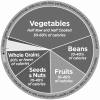Improved Cardiovascular Parameter With a Nutrient-Dense, Plant-Rich Diet-Style: A Patient Survey With Illustrative Cases
- PMID: 30202342
- PMCID: PMC6125084
- DOI: 10.1177/1559827615611024
Improved Cardiovascular Parameter With a Nutrient-Dense, Plant-Rich Diet-Style: A Patient Survey With Illustrative Cases
Erratum in
-
Corrigendum.Am J Lifestyle Med. 2018 Jul 16;12(4):349. doi: 10.1177/1559827618778628. eCollection 2018 Jul-Aug. Am J Lifestyle Med. 2018. PMID: 32063820 Free PMC article.
Abstract
Background. The results presented from a practice survey include cases of interest, demonstrating improvements in cardiometabolic risk factors utilizing a Nutrient-Dense, Plant-Rich (NDPR) diet. It includes changes in weight, blood pressure, and lipids parameters derived from the survey and retrospective chart review. Methods. Practice records and interviews were used for case history descriptions. Participants' data were collected via an online survey. Results. Adherence to a NDPR dietary protocol resulted in reduced low-density lipoprotein cholesterol and serum triglycerides. Compliance of greater than 80% with the target diet resulted in an average sustained weight loss of over 50 pounds in 75 obese subjects. There was a corresponding average reduction of 27.8 mm Hg in systolic blood pressure for the 127 survey responders with untreated hypertension at baseline, and a 42.2 mg/dL average decrease in low-density lipoprotein cholesterol for the 328 survey responders, not on cholesterol reducing medications. Conclusion. The outcomes from both the survey responders and cases demonstrate the potential for the NDPR dietary intervention to improve weight, blood pressure, lipids, and even reverse severe cardiovascular disease. Though this is a report of cases and self-reported benefits, it adds evidence to support the need for further studies investigating the potential of this dietary intervention.
Keywords: diet therapy; hypertension; lipids; nutrient dense.
Conflict of interest statement
Declaration of Conflicting Interests: The author(s) declared no potential conflicts of interest with respect to the research, authorship, and/or publication of this article.
Similar articles
-
Nutrient-dense, Plant-rich Dietary Intervention Effective at Reducing Cardiovascular Disease Risk Factors for Worksites: A Pilot Study.Altern Ther Health Med. 2016 Sep;22(5):32-6. Altern Ther Health Med. 2016. PMID: 27622958
-
Nutritional management of cardiovascular risk factors. A randomized clinical trial.Arch Intern Med. 1997 Jan 27;157(2):169-77. Arch Intern Med. 1997. PMID: 9009974 Clinical Trial.
-
Effect of a high nutrient density diet on long-term weight loss: a retrospective chart review.Altern Ther Health Med. 2008 May-Jun;14(3):48-53. Altern Ther Health Med. 2008. PMID: 18517106
-
[Pharmacological therapy of obesity].G Ital Cardiol (Rome). 2008 Apr;9(4 Suppl 1):83S-93S. G Ital Cardiol (Rome). 2008. PMID: 18773755 Italian.
-
Life-style and serum lipids and lipoproteins.J Atheroscler Thromb. 2000;7(4):177-97. doi: 10.5551/jat1994.7.177. J Atheroscler Thromb. 2000. PMID: 11521681 Review.
Cited by
-
Dietary Habits and Race Day Strategies among Flexitarian, Vegetarian, and Vegan Recreational Endurance Runners: A Cross-Sectional Investigation from The NURMI Study (Step 2).Nutrients. 2024 May 27;16(11):1647. doi: 10.3390/nu16111647. Nutrients. 2024. PMID: 38892580 Free PMC article.
-
A Worksite Nutrition Intervention is Effective at Improving Employee Well-Being: A Pilot Study.J Nutr Metab. 2018 May 2;2018:8187203. doi: 10.1155/2018/8187203. eCollection 2018. J Nutr Metab. 2018. PMID: 29854444 Free PMC article.
-
Protocol and Preliminary Results of the Nutritarian Women's Health Study: A Longitudinal Effectiveness-Implementation Hybrid Study Assessing Dietary Intake and Health Outcomes.Am J Lifestyle Med. 2020 Jan 22;15(4):453-465. doi: 10.1177/1559827619897581. eCollection 2021 Jul-Aug. Am J Lifestyle Med. 2020. PMID: 34366744 Free PMC article.
-
Effects of ad libitum consumed, low-fat, high-fiber plant-based diet supplemented with plant-based meal replacements on cardiovascular risk factors.Food Nutr Res. 2019 May 21;63. doi: 10.29219/fnr.v63.1560. eCollection 2019. Food Nutr Res. 2019. PMID: 31191190 Free PMC article.
-
Slower Pace of Epigenetic Aging and Lower Inflammatory Indicators in Females Following a Nutrient-Dense, Plant-Rich Diet Than Those in Females Following the Standard American Diet.Curr Dev Nutr. 2024 Oct 28;8(12):104497. doi: 10.1016/j.cdnut.2024.104497. eCollection 2024 Dec. Curr Dev Nutr. 2024. PMID: 39668946 Free PMC article.
References
-
- Fung TT, Schulze M, Manson JE, Willet WC, Hu FB. Dietary patterns, meat intake, and the risk of type 2 diabetes in women. Arch Intern Med. 2004;164:2235-2240. - PubMed
-
- Schulze MB, Liu S, Rimm EB, Manson JE, Willett WC, Hu FB. Glycemic index, glycemic load, and dietary fiber intake and incidence of type 2 diabetes in younger and middle-aged women. Am J Clin Nutr. 2004;80:348-356. - PubMed
-
- Liu S, Willett WC. Dietary glycemic load and atherothrombotic risk. Curr Atheroscler Rep. 2002;4:454-461. - PubMed
-
- Mursu J, Virtanen JK, Rissanen TH, et al. Glycemic index, glycemic load, and the risk of acute myocardial infarction in Finnish men: the Kuopio Ischaemic Heart Disease Risk Factor Study. Nutr Metab Cardiovasc Dis. 2011;21:144-149. - PubMed
LinkOut - more resources
Full Text Sources
Other Literature Sources

